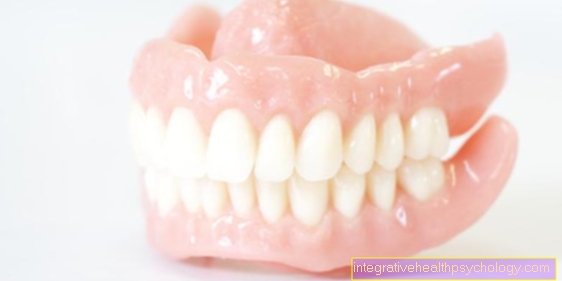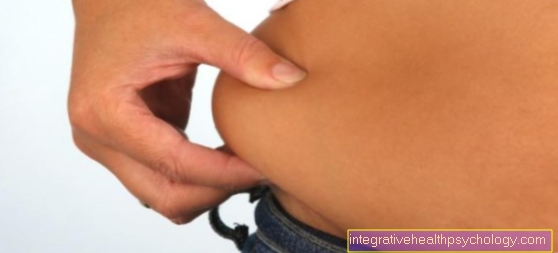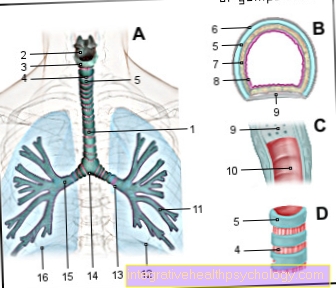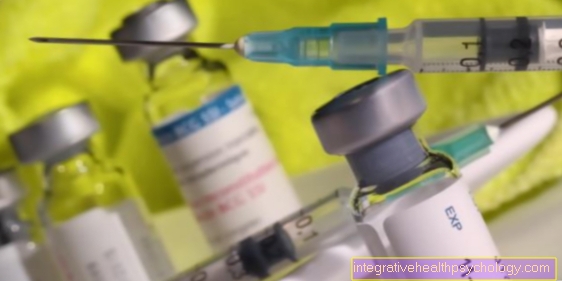Cost of a denture
introduction
The term dental prosthesis is used in dental terminology to summarize all devices that are used to replace missing, natural teeth. In general, the dentures used today are divided into two large groups, the fixed and the removable dentures. While the group of fixed dentures includes fillings and bridges as well as partial and full crowns, partial and full dentures are counted as so-called removable dentures.
Read more on the topic: Denture

A partial denture is used to replace individual missing teeth. It is fixed within the oral cavity with the help of brackets and arches and is usually very comfortable to wear because it remains seated on the alveolar ridge without any major problems. In contrast, a full dental prosthesis is equipped with a large number of artificial teeth. Such a dental prosthesis is usually made as soon as all teeth in a jaw (upper or lower jaw) have fallen out and need to be replaced.
Both the production and the creation of an ideal hold in the oral cavity is much more difficult with a full denture compared to a partial denture. The hold of total dentures is essentially created by so-called adhesive forces between the oral mucosa and the denture material. Contrary to the widespread assumption that a full denture in the upper jaw, due to the force of gravity, has a much poorer hold than in the lower jaw, the reality is rather contrary.
Total dentures of the upper jaw generally have a larger surface area. As a result, greater adhesive forces can arise between the oral mucosa and the dental prosthesis material.
In addition to the precision during the manufacture of the removable dental prosthesis, the hygienic handling of the dental prosthesis also plays a decisive role. Dentures that are seldom cleaned and, for this reason, have heavy deposits, generally hardly find any hold on the alveolar ridge.
Find out more about the topic: Interim prosthesis
Cost of a denture
How high the cost of making and fitting a denture differs from patient to patient. When calculating the actual price, it must be noted that the scope of the prosthetic work, the choice of material and also the respective dental practice and the dental laboratory have a decisive influence on the final price to be paid. For this reason, the costs can fluctuate widely within Germany.
The cost of a dental prosthesis is generally made up of various billable individual services. One of the most extensive cost points when making a dental prosthesis is the dental fee. When providing a standard service, this fee, i.e. the portion to which the treating dentist is entitled as work, is calculated based on the BEMA (assessment standard for dental services) agreed with the health insurance companies. If the patient wants a dental prosthesis that goes beyond the standard care (better material, more attractive veneer, etc.), in addition to the BEMA values, costs that are based on the fee schedule for dentists (in short: GOZ) will be charged. These are private services that are not covered by the health insurances and therefore have to be borne by the patient himself.
When billing according to the schedule of fees for dentists, in contrast to the BEMA fixed price, the dentist has the option of including the individual workload of the respective patient in the cost calculation. For this reason, the schedule of fees for dentists works with so-called increase rates, through which a basic price can be increased by a certain factor. The mean value is a rate of increase of 2.3. With a written justification, the costs can even be increased to 3.5 times the rate.
Another cost point in the manufacture of the dental prosthesis is the fee that the dental laboratory is entitled to (laboratory costs). These services include the workload of the dental technician and the material costs. In addition, other material costs that arise from the pretreatment and insertion of the dental prosthesis within the dental practice (material costs) must be included in the determination of the total price.
What does an upper jaw prosthesis cost?
The costs for an upper jaw prosthesis in the toothless jaw amount to 400-500 euros. When teeth, snaps or implants are integrated, the costs increase. A telescopic prosthesis with several teeth costs 3000-6000 euros, implants are often even more expensive. A price comparison can be worthwhile, especially for implants, as they are set privately by the dentist.
What does a mandibular prosthesis cost?
Creating a mandibular prosthesis without the presence of teeth or implants that need to be integrated into the prosthesis costs around 400-500 euros. If four snap fasteners or mini implants are inserted into the lower jaw for anchoring, these cost around 2000 euros with the prosthesis. As soon as there are still teeth or real implants, these are also anchored in the prosthesis. If there are one or two implants or teeth that are incorporated as telescopes, the prosthesis costs well over 1500 euros.
The integration of further teeth or implants increases the effort and at the same time the costs, so that the sum of a small car can be reached quickly. A lower jaw prosthesis with 4 implants can cost 7,000-8,000 euros. In the case of implants, it is advisable to obtain a price comparison, as they are completely private and every dentist can decide for himself how expensive the implants are. Only the dentures on the implants are subsidized by the health insurance.
How expensive are snaps?
A push button or a so-called mini-implant is a complete private service that is not subsidized by health insurance. The dentist can therefore decide for himself how expensive an inserted mini-implant is. In the lower jaw 4 press studs are necessary to stabilize the prosthesis, in the upper jaw 6. The costs vary greatly, so a price comparison is also advisable. The patient should expect costs from 500 euros per mini-implant.
What does a bridge cost?
The cost of a bridge to replace tooth gaps depends on the design and materials. The decisive factor is how many links this bridge consists of, meaning abutment teeth and bridge body. A bridge that only replaces one tooth is cheaper than a longer-span bridge that, for example, replaces two or three teeth and integrates more abutment teeth. The material used to determine the price is also crucial. The cheapest option would be a bridge made of non-precious metal, a non-precious metal alloy made of chrome, cobalt and molybdenum. This bridge is silver to gray and not adapted to a tooth color. This bridge construction can be veneered in the color of the tooth, but this is associated with additional costs. The most expensive variant is a bridge that is completely tooth-colored, which means that the framework is also tooth-colored. These bridges are made of zircon and produce the best aesthetic result.
Read more on the topic: Dental bridge as a dental prosthesis
As an example calculation, a three-unit bridge, i.e. a bridge that replaces one tooth and crowns the two neighboring teeth, costs around 800 euros. If this is veneered, it costs around 1000-1200 euros and zirconia around 1500-2000 euros. A Maryland bridge, an adhesive bridge in the front, costs around 1000 euros. The health insurance company also pays a portion of the costs, depending on the size of the bonus. This includes a maximum reimbursement of costs of 30%, provided the patient has attended the annual check-up for ten years in a row. For five consecutive years, the health insurance pays 20%. It can also be the case that the health insurance company pays 100% in a hardship case if the patient has a very low income. The hardship application must be submitted separately by the patient to his health insurance company. Privately insured patients pay part or all of the costs, depending on the insurance conditions.
How expensive is it to repair a denture?
The cost of prosthesis repairs depends on the type of repair. If the dental prosthesis is broken in the plastic area of the base, the broken fragments must be put together. This repair costs around 80-100 euros. A stabilizing metal net can be built into the plastic base as a support, which protects against further breaks and costs around 40 euros. The health insurance also pays part of this.
If a tooth has broken out of the prosthesis, it must be replaced in the prosthesis, which costs 60 - 80 euros. If there are several teeth, the amount increases accordingly. If there are broken metal parts in the prosthesis, the repair may be more expensive as it is much more complex. It becomes more complex because the metal parts have to be soldered at very high temperatures, which means that all plastic parts melt because they cannot withstand the temperatures. Therefore, the plastic must also be renewed. These repairs start from 150 euros. The share that the health insurance company undertakes depends on the bonus of the person concerned.
How expensive is a dental prosthesis relining?
The relining of a prosthesis, i.e. the filling of hollow areas with plastic, is not laborious laboratory work. The technician fills the areas that are not in contact with liquid plastic, presses the prosthesis under pressure and polishes the worked areas again. The patient has to go without his prosthesis for about half a day and the relining costs him around 80-120 euros.
Takeover by the health insurance company
As mentioned earlier, on average, dentures are not completely affected by the Health insurance accepted. However, there are ways in which the patient can contribute to the Fixed allowance, which is worn can increase significantly. Regular participation in the dental check-ups (Bonus program), the grants can be increased by up to 30 percent increase. Also the completion of a Supplementary dental insurance is becoming more and more important when it comes to the cost of dental services. On average, the costs for the manufacture and insertion of a dental prosthesis (e.g. full denture) in Germany are around 1400 euros. The dentist's fee accounts for a proportion of this total price 500 euro a. The costs incurred through the work of the dental laboratory are on average around 900 euros. Furthermore, the material costs of the dental practice add up to around 50-70 euros. According to some statistics, the patient who did not participate in the bonus program amounts to around approximately 50%. In such cases, the health insurance company only pays half of the costs.




























